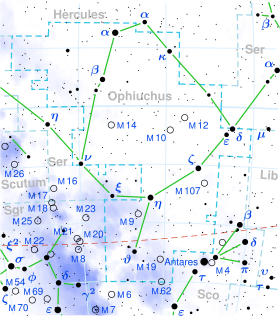Star in the constellation Ophiuchus
μ Ophiuchi , Latinized as Mu Ophiuchi , is a solitary,[ 10] star in the equatorial constellation of Ophiuchus . It is visible to the naked as a faint point of light with an apparent visual magnitude of 4.62.[ 2] light years away from the Sun based on parallax ,[ 5] radial velocity of −18.5 km/s.[ 4]
This object has a stellar classification of B8II-IIIp:Mn,[ 3] luminosity class with mixed traits of a giant or bright giant star . The suffix notation indicates it is a candidate chemically peculiar star with an overabundance of manganese in its spectrum . It may be a mercury-manganese star .[ 11] radius of the Sun and is radiating nearly 400 times the Sun's luminosity from its photosphere at an effective temperature of 7,748 K.[ 1] projected rotational velocity of 95 km/s.[ 8]
In 2006, a new nearby star cluster , Mamajek 2 (), was discovered. Mu Ophiuchi is a candidate member.[ 12] ± 25[ 13]
References
^ a b c d e f Brown, A. G. A. ; et al. (Gaia collaboration ) (August 2018). "Gaia Data Release 2: Summary of the contents and survey properties" . Astronomy & Astrophysics 616 . A1. arXiv :1804.09365 Bibcode :2018A&A...616A...1G doi :10.1051/0004-6361/201833051 Gaia DR2 record for this source at VizieR .^ a b c d Ducati, J. R. (2002). "VizieR Online Data Catalog: Catalogue of Stellar Photometry in Johnson's 11-color system". CDS/ADC Collection of Electronic Catalogues . 2237 . Bibcode :2002yCat.2237....0D . ^ a b Cowley, A. (November 1972). "Spectral classification of the bright B8 stars". Astronomical Journal . 77 : 750– 755. Bibcode :1972AJ.....77..750C . doi :10.1086/111348 . ^ a b Gontcharov, G. A. (2006). "Pulkovo Compilation of Radial Velocities for 35 495 Hipparcos stars in a common system". Astronomy Letters . 32 (11): 759– 771. arXiv :1606.08053 Bibcode :2006AstL...32..759G . doi :10.1134/S1063773706110065 . S2CID 119231169 . ^ a b c d Van Leeuwen, F. (2007). "Validation of the new Hipparcos reduction". Astronomy and Astrophysics . 474 (2): 653– 664. arXiv :0708.1752 Bibcode :2007A&A...474..653V . doi :10.1051/0004-6361:20078357 . S2CID 18759600 . Vizier catalog entry ^ Anderson, E.; Francis, Ch. (2012). "XHIP: An extended hipparcos compilation". Astronomy Letters . 38 (5): 331. arXiv :1108.4971 Bibcode :2012AstL...38..331A . doi :10.1134/S1063773712050015 . S2CID 119257644 . Vizier catalog entry ^ Gontcharov, G. A. (2012). "Dependence of kinematics on the age of stars in the solar neighborhood". Astronomy Letters . 38 (12): 771– 782. arXiv :1606.08814 Bibcode :2012AstL...38..771G . doi :10.1134/S1063773712120031 . S2CID 118345778 . Vizier catalog entry ^ a b Abt, Helmut A.; et al. (2002). "Rotational Velocities of B Stars" . The Astrophysical Journal . 573 (1): 359– 365. Bibcode :2002ApJ...573..359A . doi :10.1086/340590 ^ "mu. Oph" . SIMBAD Centre de données astronomiques de Strasbourg .^ Eggleton, P. P.; Tokovinin, A. A. (September 2008). "A catalogue of multiplicity among bright stellar systems" . Monthly Notices of the Royal Astronomical Society 389 (2): 869– 879. arXiv :0806.2878 Bibcode :2008MNRAS.389..869E . doi :10.1111/j.1365-2966.2008.13596.x S2CID 14878976 . ^ Renson, P.; Manfroid, J. (May 2009). "Catalogue of Ap, HgMn and Am stars" . Astronomy and Astrophysics . 498 (3): 961– 966. Bibcode :2009A&A...498..961R . doi :10.1051/0004-6361/200810788 ^ Mamajek, Eric E. (2006). "A New Nearby Candidate Star Cluster in Ophiuchus at d = 170 pc". Astronomical Journal . 132 (5): 2198– 2205. arXiv :astro-ph/0609064 Bibcode :2006AJ....132.2198M . doi :10.1086/508205 . S2CID 14070978 . ^ Jilinski, E.; et al. (January 2009). "Dynamical Evolution and Spectral Characteristics of the Stellar Group Mamajek 2". The Astrophysical Journal . 691 (1): 212– 218. arXiv :0810.1198 Bibcode :2009ApJ...691..212J . doi :10.1088/0004-637X/691/1/212 . S2CID 15570695 .














